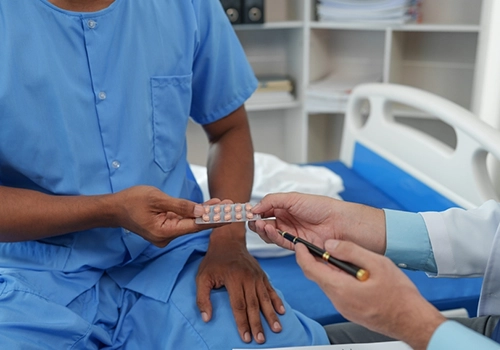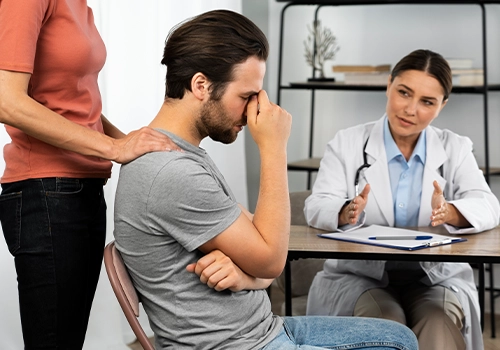Testicular Cancer
We deem it necessary to mention that the presence and occurrence of these symptoms do not necessarily imply a diagnosis of cancer. Readers of this article should be mindful that self-examination by non-specialists should not lead to unnecessary fear and anxiety.
On the other hand, it’s important to remember that advancements in medical science worldwide have greatly improved the chances of treating various forms of cancer. Therefore, there is no cause for undue concern regarding the treatability of this disease. Prompt action, however, facilitates treatment with ease.
What is Testicular Cancer
Testicles, Male gonads, produce sperm and the hormone testosterone. Testicles are two egg-shaped masses situated in a thin pouch of skin called the scrotum. Due to certain abnormal and unknown occurrences, testicles can become cancerous.
Testicular cancer is a type of disease that develops by forming cancerous (malignant) cells in testicular tissues. Cancerous cells can develop in both testicles, although this is quite rare.
Fortunately, this disease is relatively rare and accounts for only one percent of all male cancers. Testicular cancer stands out among other cancers because it tends to affect young men. Although it is relatively uncommon overall, it is the most common type of cancer in men aged 15 to 49.
In most cases, this disease is treatable. For reasons that are not clear, white men are more susceptible to testicular cancer compared to men of other ethnic groups.
Causes of Testicular Cancer
Although scientists do not fully understand the exact cause of testicular cancer, certain factors may increase the risk of developing this disease. These factors include:
- Undescended Testicles: If testicles do not descend properly at birth, the child is at risk of developing testicular cancer in the future.
- Congenital Issues: Children born with congenital problems related to their reproductive organs, kidneys, or testicles may be at higher risk.

- Previous Testicular Cancer: Men who have previously had testicular cancer are at a higher risk of developing it again compared to the general population.
- Family History: Men with close relatives who have a history of testicular cancer are at an increased risk.
- Abnormal Testicular Growth: Conditions like Klinefelter syndrome, where testicles exhibit abnormal growth, can elevate the risk of testicular cancer.
- Orchitis: A rare complication of orchitis may lead to inflammation in one or both testicles.
- Ethnicity: It is seen more in white men than other races. Testicular cancer is more common among Caucasians compared to men of African or Asian descent.
- Age: Testicular cancer affects teenagers and younger men, especially people aged 15 to 35, however, it can occur at any age.
- HIV Infection: Some evidence shows that men infected with the HIV are at a higher risk of developing this cancer.
- Genital warts
Note: Vasectomy does not increase the risk of testicular cancer.
Diagnosing Testicular Cancer
There are several diagnostic methods for testicular cancer, including:
- Physical examination: Touching a hard lump without pain, a change in the shape of the testicle tissue, or swelling of the testicle is the first way of early diagnosis by the individual himself.
- Blood Tests:
In this method, cancer markers such as Alpha-fetoprotein (AFP), Human chorionic gonadotropin (hCG), and Lactate dehydrogenase (LDH) are investigated. However, blood tests may be normal despite the presence of cancer.
- Testicular Ultrasound:
A testicular ultrasound can detect the presence and size of a tumor. It is highly accurate, with over 90% precision in diagnosing testicular cancer. Any hypoechoic mass in the testicle is considered indicative of testicular cancer unless proven otherwise.
- Testicular Biopsy:
A small tissue sample is taken from the testicle and examined under a microscope to determine if the mass is malignant (cancerous) or benign (non-cancerous).
- MRI Scan:
When this condition spreads, it often affects lymph nodes in the abdomen or the lungs. An X-ray of the chest may be needed to evaluate symptoms. Additionally, a CT scan of the entire body is essential to assess the extent of the disease. In some cases, an MRI scan may be performed.
Symptoms of Testicular Cancer
Usually, symptoms of testicular cancer do not appear until the later stages of the disease. In most cases, individuals become aware of it themselves or during routine medical examinations conducted by a physician. Anyone who notices something unusual related to their testicle should promptly seek medical attention, especially if they experience any of the following:

- A painful lump or swelling in the testicle.
- Feeling of heaviness or discomfort in the testicle or scrotum.
- General discomfort or pain in the testicle or scrotum.
- Vague discomfort in the groin, lower back, or abdomen.
- Sudden accumulation of fluid in the scrotum.
In fact, less than 4% of testicular masses are cancerous. However, individuals should not ignore testicular masses and should consult a physician. Only medical professionals can determine the cause. Although testicular cancer can spread to lymph nodes, it is rare for it to spread to other organs.
If cancer does spread to other organs, a person may experience the following symptoms:
- Coughing
- Breathing difficulties
- Swallowing problems
- Chest swelling
Stages of Testicular Cancer Treatment
The choice of testicular cancer treatment options depends on various factors, including the type and stage of cancer, overall health, and patient preferences.
Surgical Treatment for Testicular Cancer
Surgical procedures used to treat testicular cancer include:
- Orchiectomy (Radical Inguinal Orchiectomy, Surgery to remove the testicle):
This approach is almost always the main treatment for all stages and types of testicular cancer. To perform an orchiectomy, a surgeon makes an incision in the groin and removes the testicle. If desired, a prosthetic testicle can be implanted as a replacement. In the early stages of testicular cancer, surgical removal of the testicle may be the only required treatment.
- Lymph Node Dissection:
Retroperitoneal lymph node dissection involves removing lymph nodes through an incision in the abdomen.
If surgery is the only treatment option for testicular cancer, regular follow-up visits for health monitoring, including blood tests, CT scans, and other tests to check for signs of cancer recurrence, are recommended.”
Radiation Therapy for Testicular Cancer
In radiation therapy, high-energy rays such as X-rays are used to target and eliminate cancer cells. During radiation therapy, the patient lies on a table, and a large machine moves around them, precisely directing high-energy rays to specific areas of the body.
Radiation therapy is a treatment option sometimes used for individuals with seminoma-type testicular cancer. It may be recommended after the surgical removal of the testicle.
Radiation therapy can have side effects, including nausea, fatigue, redness of the skin, irritation in the abdominal and groin area. It can temporarily reduce sperm count and may affect fertility in some men. Before starting radiation therapy, discussions with a doctor about sperm preservation options are advisable.

Chemotherapy for Testicular Cancer
In chemotherapy, drugs are used to target and eliminate cancer cells. Chemotherapy is used for cancer cells that have likely migrated from the primary tumor and spread throughout the body. It can be the only treatment option or may be administered before or after surgery.
The side effects of chemotherapy depend on the specific drugs used. Common side effects include fatigue, nausea, hair loss, and an increased risk of infection. Some medications and treatments can mitigate certain chemotherapy side effects.
Chemotherapy can also lead to infertility in some men, and in some cases, this effect may be permanent.
After conducting all relevant tests, the doctor can determine the stage and grade of the cancer, helping to tailor the treatment approach.
Stage 1: Cancer is confined to the testicles and has not spread to other parts of the body.
Stage 2: Cancer has spread to abdominal lymph nodes.
Stage 3: Cancer has spread to other parts of the body, including the lungs, liver, brain, and bones.
Types of Testicular Cancer
Testicular cancer has different types based on the type of cells where the cancer originates. The most common type of testicular cancer is Germ Cell Cancer (seminoma), accounting for approximately 95% of all cases. Germ cells are the type of cells the body uses to produce sperm.
There are two main types of testicular cancer, which are as follows:
- Seminoma: Over the past 20 years, the incidence of seminoma has been steadily increasing and it now comprises 40 to 45% of testicular cancers.
- Non-Seminoma: it is another part of germ cell cancer. This category includes various subtypes such as teratoma, embryonal carcinoma, choriocarcinoma, and yolk sac tumors. Non-seminoma cancers are more common among young men.
Note: Both types of germ cell testicular cancer respond well to chemotherapy.
Less common types of testicular cancer include the following:
- Leydig cell tumors, account for about one to three percent of cases.
- Sertoli cell tumors, make up less than one percent of cases.
Testicular Cancer Treatment
Approximately 95% of men diagnosed with testicular cancer achieve a complete cure after treatment. Early diagnosis leads to a better prognosis. Treatment for testicular cancer can include surgery, radiotherapy, chemotherapy, or a combination of these methods.
Testicular Cancer Treatment Stages
Stage 1: Testicular cancer or STAGE 0 includes:
- Radiation therapy
- Patient monitoring
- Orchiectomy (removal of the testicle)

Stage2, STAGE 1:
The treatment approach varies depending on whether it is a seminoma or non-seminoma type of cancer.
For seminoma type, it includes:
- Removal of the testicle with careful patient monitoring
- If the patient requires intensive treatment, the treatment plan involves orchiectomy followed by chemotherapy.
For non-seminoma type, the treatment plan includes:
- Removal of the testicle with long-term patient monitoring
- Removal of the testicle and abdominal lymph nodes (retroperitoneal) with long-term patient monitoring
- After surgery, chemotherapy for patients with a risk of cancer recurrence.
Stage 3: STAGE 2 Testicular Cancer
For seminoma-type cancer, the treatment options include:
- If the tumor is 5 centimeters or smaller, it necessitates orchiectomy and radiation therapy to the lymph nodes in the back and abdomen or orchiectomy and abdominal lymph node surgery.
- If the tumor is larger than 5 centimeters, the treatment plan involves orchiectomy with radiation therapy, chemotherapy, and long-term follow-up.
For non-seminoma type STAGE 2 cancer:
- Removal of the testicle and lymph nodes with long-term follow-up
- Removal of the testicle and lymph nodes followed by radiation therapy and chemotherapy.
Testicular Cancer Recurrent Treatment
Treatment for recurrent testicular cancer involves:
- Radiation therapy and chemotherapy
- Prescribing high-dose chemotherapy
- Surgical removal of the recurrent cancer, depending on whether the cancer has recurred within two years or in a specific location.
Preventing Testicular Cancer
There is no known way to prevent testicular cancer, but early detection is crucial. Men should perform monthly testicular self-examinations (TSE). If men over the age of 15 are not familiar with how to perform TSE, they should ask their doctor to teach them.
If an individual notices any changes in the testicles (such as a lump, hardening, persistent pain, or changes in size, either enlargement or shrinkage), they should promptly consult a doctor.
Starting treatment as early as possible significantly increases the chances of a complete cure for individuals with testicular cancer. Even when cancer is completely cured, there is still a risk of recurrence. The risk of cancer recurrence depends on the stage at which it was diagnosed and when treatment began. Recurrences in non-seminoma testicular cancer typically occur within two years after surgery or completion of chemotherapy.

In seminoma testicular cancer, recurrences can happen up to three years later. Recurrence beyond three years is rare and occurs in less than five percent of cases. Due to the risk of recurrence, regular check-ups to monitor for cancer relapse are necessary.
This type of cancer is successfully treated in over 95 percent of cases. Even men with high-risk factors have, on average, a 50 percent chance of successful treatment. Like many other cancers, medical professionals continue to strive for innovative treatment methods.
the Last Word
Embarking on a journey of health and awareness is crucial, especially when it comes to understanding and addressing concerns like testicular cancer.
In your consultation with Dr. Maadico’s Medical Department, you can gain valuable insights into the complexities of testicular cancer, its potential causes, and the various treatment options available.
Whether you’ve noticed unusual symptoms, or have questions about preventive measures, Dr. Maadico is here to provide personalized and comprehensive assistance.
Take the first step towards proactive well-being by scheduling a consultation with Dr. Maadico’s Medical Department. our expertise in the cancer field, coupled with a compassionate approach, ensures that your health concerns are met with the utmost care.
Get a Free Consultation
Frequently Asked Questions
1.what is the cost of Testicular Cancer treatment?
The cost of testicular cancer treatment can vary widely based on factors such as the stage of cancer, the type of treatment required, geographic location, and individual healthcare plans. Treatment may include surgery, chemotherapy, and radiation therapy.
2.What are the ways to prevent Testicular Cancer?
Although there is no foolproof method to prevent testicular cancer, certain strategies may help reduce the risk:
- Conduct regular self-exams to identify any abnormal lumps or changes in the testicles.
- Seeking prompt medical attention for any concerns or abnormalities.
- Maintaining a healthy lifestyle, which includes adopting a balanced diet and engaging in regular exercise.

It’s important to note that testicular cancer is not exclusively an inherited disease; however, some cases may involve a genetic component. Individuals with a family history of testicular cancer might face a slightly elevated risk.
3.Is Testicular Cancer an inherited disease?
Yes, Testicular Cancer can be hereditary. Having a family history of testicular cancer increases your risk, especially if an immediate family member has had it before. Almost half of the risk of developing testicular cancer comes from the DNA passed down from our parents.
4.How long is the hospitalization period for Testicular Cancer surgery?
The hospitalization period for testicular cancer surgery can vary depending on the severity of the spread of the disease, specific surgical methods, and individual recovery. In some cases, patients may be able to go home on the same day as the surgery, while more complex cases may require a longer hospital stay. After surgery to remove the testicle, most men can go back to normal activities after 2 weeks.
5.What are the post-operative care procedures for Testicular Cancer?
Post-operative care for testicular cancer involves several essential procedures. These include applying an ice pack to alleviate swelling, maintaining the incision area’s dryness during the initial days, and adhering to prescribed medications and ointments from your healthcare provider.
Patients are further encouraged to take a period of rest for the first few days post-surgery, refraining from lifting heavy objects, engaging in sexual activity, or participating in strenuous exercises for a few weeks.
6.What is the role of nutrition in Testicular Cancer development?
Nutrition holds a crucial role in both overall health and the recovery process from Testicular Cancer. Consuming a well-balanced diet can contribute to increased strength, improved tolerance of treatments, and overall support for recovery.
It is advisable to include antioxidant-rich foods in your diet to help mitigate inflammation and promote testicular health. Nevertheless, it’s important to note that there is currently no evidence-based diet specifically tailored for the treatment of Testicular Cancer.
7.Does alcohol, smoking, and addiction play a role in Testicular Cancer?
The connection between alcohol, smoking, and addiction in relation to testicular cancer is not firmly established. However, it is known that the combination of alcohol and smoking significantly amplifies the risk of various cancers compared to the risks associated with each individually.
In light of these considerations, it is generally recommended to maintain a healthy lifestyle by steering clear of tobacco use and limiting alcohol consumption.


